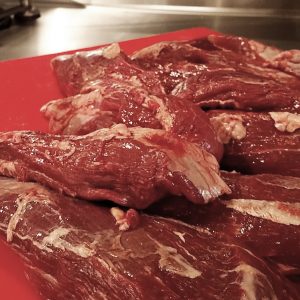If you’ve been by the Via Umbria meat counter lately you may have noticed a steak called the teres major. Despite its strange sounding name (it is the scientific name for the muscle, one that humans also have), the teres major is actually steak familiar to most of us. Cut off of the chuck, the shoulder of the cow that is traditionally used for ground or stew meat, the teres major is a muscle that is rarely, if ever, used by the cow during its lifetime. This gives it a unique set of qualities when it’s time for the cook to take over. First and foremost, it is soft. This means that even after you cook it, even when you cook it well done, it is tender. Secondly, there is virtually no intramuscular fat. This is the type of fat that gives the ribeye its pronounced rich flavor, and it is the type of fat that is impossible to avoid eating (not that you really should want to). There is one other muscle that has these two qualities: the beef tenderloin, or as it is known on most steakhouse menus: the filet mignon.
The thing that both of these qualities have in common is: you can see or feel them when the steak is still raw. When you walk into butcher shops it may be overwhelming when you see steaks or cuts of pork that you have never heard of. Don’t be intimidated! Talk to your butcher, but you can also look for a few simple things:
1. Fat cap – This will help protect your meat, keeping it moist while cooking, but it can also catch aflame when grilling. I always advise removing the fat cap after cooking, if you don’t want to eat it. That being said, I also think it looks great on a plate.
2. Visible grain – You’ve probably heard the expression “slice against the grain,” and that’s 100% true. That being said, there are several steaks with visible grain running perpendicular to the length of the steak. These are your hanger steaks, skirt steaks, bavette (flap meat) steaks, et cetera. In Italy these are the steaks called tagliata di mazo, sliced beef steak. In the New World, the skirt and the bavette are the most common cuts used in fajitas.
3. Intramuscular Fat – These small flecks of white within the meat are what give the ribeye its prowess as a steak. Unlike the fat cap, this is a fat that cannot be removed. But why would you? This is a fat that adds a richness of flavor that makes the steak versatile. It can be sliced thick and eaten as a steak, it can be ground, it can even be sliced think and served on a bread with some cheese whiz or provolone!
4. Pliability – This is the one that needs to be felt rather than seen. Both the tenderloin and the teres major are incredibly soft and flexible when raw. That is how you know they are incredibly tender.
So this isn’t a complete list by any stretch. There are so many different cuts of beef that can be used as steak or otherwise. It is, however, the four most important factors for me when judging how I will prepare the meat that I have purchased. It also helps you when you have a recipe that calls for a specific cut that you can’t locate (even though, if you call us in advance, we’ll have it for you!). There is always a similar enough cut of meat that you can use. Just don’t be afraid to ask!




